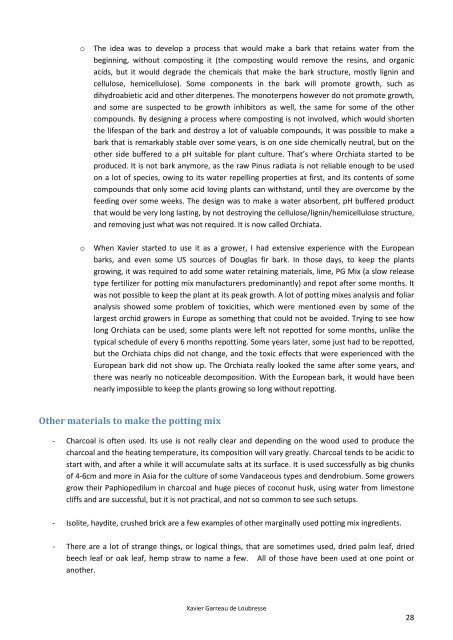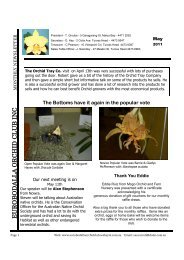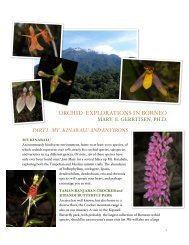Orchid Growing Substrates
Orchid Growing Substrates
Orchid Growing Substrates
You also want an ePaper? Increase the reach of your titles
YUMPU automatically turns print PDFs into web optimized ePapers that Google loves.
o<br />
o<br />
The idea was to develop a process that would make a bark that retains water from the<br />
beginning, without composting it (the composting would remove the resins, and organic<br />
acids, but it would degrade the chemicals that make the bark structure, mostly lignin and<br />
cellulose, hemicellulose). Some components in the bark will promote growth, such as<br />
dihydroabietic acid and other diterpenes. The monoterpens however do not promote growth,<br />
and some are suspected to be growth inhibitors as well, the same for some of the other<br />
compounds. By designing a process where composting is not involved, which would shorten<br />
the lifespan of the bark and destroy a lot of valuable compounds, it was possible to make a<br />
bark that is remarkably stable over some years, is on one side chemically neutral, but on the<br />
other side buffered to a pH suitable for plant culture. That’s where Orchiata started to be<br />
produced. It is not bark anymore, as the raw Pinus radiata is not reliable enough to be used<br />
on a lot of species, owing to its water repelling properties at first, and its contents of some<br />
compounds that only some acid loving plants can withstand, until they are overcome by the<br />
feeding over some weeks. The design was to make a water absorbent, pH buffered product<br />
that would be very long lasting, by not destroying the cellulose/lignin/hemicellulose structure,<br />
and removing just what was not required. It is now called Orchiata.<br />
When Xavier started to use it as a grower, I had extensive experience with the European<br />
barks, and even some US sources of Douglas fir bark. In those days, to keep the plants<br />
growing, it was required to add some water retaining materials, lime, PG Mix (a slow release<br />
type fertilizer for potting mix manufacturers predominantly) and repot after some months. It<br />
was not possible to keep the plant at its peak growth. A lot of potting mixes analysis and foliar<br />
analysis showed some problem of toxicities, which were mentioned even by some of the<br />
largest orchid growers in Europe as something that could not be avoided. Trying to see how<br />
long Orchiata can be used, some plants were left not repotted for some months, unlike the<br />
typical schedule of every 6 months repotting. Some years later, some just had to be repotted,<br />
but the Orchiata chips did not change, and the toxic effects that were experienced with the<br />
European bark did not show up. The Orchiata really looked the same after some years, and<br />
there was nearly no noticeable decomposition. With the European bark, it would have been<br />
nearly impossible to keep the plants growing so long without repotting.<br />
Other materials to make the potting mix<br />
- Charcoal is often used. Its use is not really clear and depending on the wood used to produce the<br />
charcoal and the heating temperature, its composition will vary greatly. Charcoal tends to be acidic to<br />
start with, and after a while it will accumulate salts at its surface. It is used successfully as big chunks<br />
of 4-6cm and more in Asia for the culture of some Vandaceous types and dendrobium. Some growers<br />
grow their Paphiopedilum in charcoal and huge pieces of coconut husk, using water from limestone<br />
cliffs and are successful, but it is not practical, and not so common to see such setups.<br />
- Isolite, haydite, crushed brick are a few examples of other marginally used potting mix ingredients.<br />
- There are a lot of strange things, or logical things, that are sometimes used, dried palm leaf, dried<br />
beech leaf or oak leaf, hemp straw to name a few. All of those have been used at one point or<br />
another.<br />
Xavier Garreau de Loubresse<br />
28
















